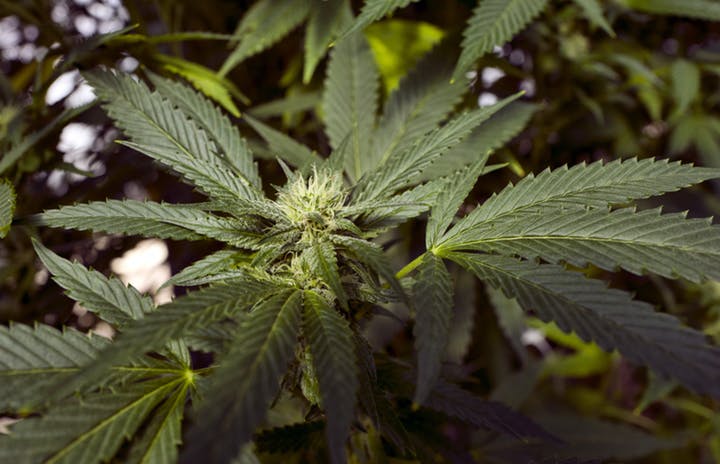Shirola: It’s time to legalize marijuana at the federal level
Richard Vogel/Star Tribune/TNS
A marijuana plant.
April 9, 2019
This is the first column in “Failed Policy,” a series examining the history of drugs and drug policy in the United States since its founding.
Marijuana has a long and interesting history in the United States. While our country has only been around for a few hundred years, marijuana, the dried and shredded flowers and leaves of the hemp plant, has existed for ages.
There is evidence that marijuana was widely used for medicinal and spiritual purposes in ancient China. The Vikings and medieval Germans used it for pain relief during childbirth and toothaches. Traces have even been found at the prehistoric sites of hunters and gatherers. Clearly, marijuana has been legal in many regions of the world for most of its history.
Marijuana was still legal when the United States was founded. Indeed, domestic production of the hemp plant was actually encouraged by the U.S. government in the 17th century for the production of rope, sails and clothing. Marijuana, itself, however, was not widely used recreationally during this time. Rather, its recreational use came in the first few decades of the 20th century. During the Mexican Revolution, Mexican immigrants came to the United States and brought recreational marijuana with them.
The Americans’ fear toward Mexican immigrants was quickly associated with marijuana itself. During the Great Depression, massive unemployment increased fear of Mexican immigrants and marijuana, since most of it came from the southern border. Government-sponsored research immediately began linking marijuana use with violence, crime and mental illness. By 1931, 29 states had made marijuana illegal.
A few years later, Congress enacted a nationwide ban via the Marijuana Tax Act of 1937. The U.S. Border Patrol began proclaiming the drive against “Mexican marihuana” as a justification for spending more and more money to “secure the border.”
When President Richard Nixon launched the “war on drugs” and marijuana was classified as a Schedule One drug, classified as having “no currently accepted medical use and a high potential for abuse,” the Border Patrol focused even more attention on drug smuggling at the southern border. Thus, we see some of the origins of the Border Patrol. It was created to prevent both immigrants and drugs from coming in.
Marijuana is not illegal because it is harmful. It is illegal because of where it comes from and who is associated with using it. Legalizing it, however, will likely lower illicit smuggling significantly. Take alcohol, for example. During Prohibition, the Border Patrol confiscated millions of quarts of liquor a year at the southern border. Year after year, more agents, vehicles, and airplanes were requested to keep up with the illegal smuggling of alcohol. When Prohibition was repealed in 1933, the illicit smuggling of liquor dropped by 90 percent. By 1935, illegal smuggling of liquor across the border had disappeared completely.
This is precisely why I propose legalizing marijuana: Because legalization does what fences cannot. Since 2012, when Colorado and Washington state legalized recreational marijuana, many states have followed including Nevada, Alaska and California. In fact, if current trends continue, by 2020 a large fraction of Americans will live in a state where recreational marijuana is permitted. What happened when marijuana was legalized in these states? Less weed was seized coming across the southern border while legal sales increased. Meanwhile, marijuana usage barely budged.
There is really no reason that the federal government shouldn’t fully legalize marijuana. In fact, its current standing as illegal seems to directly contradict the beautiful forces of free-market capitalism. Indeed, the country would reap many benefits if marijuana were legalized at the federal level. First, the marijuana industry, on both the recreational and medicinal sides, saw significant job creation in 2018, with close to 65,000 new jobs added. Additionally, according to a recent report compiled by Leafly and Whitney Economics, “the legal [marijuana] industry remains a substantial and unrecognized engine of grassroots job creation.”
Marijuana legalization also promises to bring a huge boost to the U.S. economy as a whole. Tilray, one of the world’s most valuable pot companies, envisions a $100 billion future with plans to take advantage of the burgeoning market for consumer products that use ingredients from marijuana. Everything from marijuana-infused beauty products to marijuana-infused beer could literally upend the current consumer-goods market as we know it. All of this is in addition to the growing list of medical conditions that marijuana has been prescribed to help treat or alleviate including multiple sclerosis, cancer and epilepsy.
The answer to the marijuana debate is clear: Legalize it. There is simply nothing to lose, and everything to gain. But, when the federal government finally comes to its senses, it needs to keep it simple. Minimize rules and regulations and let Adam Smith’s invisible hand guide us to a better future.
Wesley Shirola is a Weinberg sophomore. He can be contacted at [email protected]. If you would like to respond publicly to this column, send a Letter to the Editor to [email protected]. The views expressed in this piece do not necessarily reflect the views of all staff members of The Daily Northwestern.


